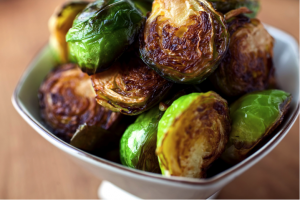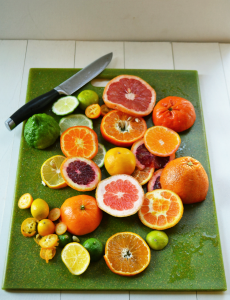Unique Health Benefits of Winter Produce
Posted on Categories Discover Magazine

Guest post by Earlene Mulyawan
Winter season is when comfort food seems to take priority over fresh produce. But eating local during winter season is easy! There are plenty of produce that are rich in nutrients and flavor during this time of the year. Winter produce can also be just as tasty and nutritious with some creativity and a little twist. Read on to learn about how these three winter vegetables.
Photo Credit: Nourish Evolution
Beets are round, little balls of vegetables that grow underground. They taste a little like dirt too, but in a unique sweet and earthy way. What gives these rooty vegetables their earthy flavor and aroma is an organic compound called geosmin, which is produced by microbes in the soil. It is also the main contributor to the strong scent that occurs when rain falls after a dry weather. Beets are an excellent source of betaine, a nutrient that has potential to help fight inflammation, improve vascular risk factors, enhance performance [1]. As a group, the anti-inflammatory molecules found in beets may provide cardiovascular benefits as indicated by large-scale studies, as well as anti-inflammatory benefits for other body systems [2]. There are many ways you can enjoy eating beets. You can eat them raw, roasted, as a salad topping, or pickled!

Photo Credit: The New York Times
Brussels sprouts, along with kale, cabbage, and broccoli, are members of the cruciferous family of vegetables. However, many scientists favor the term “brassica vegetables” over “cruciferous vegetables.” Brassica vegetables are unique because they are rich in sulfur-containing compounds called glucosinolates. Our body converts glucosinolates to indoles and isothiocyanates. Epidemiological studies indicate that human exposure to isothiocyanates and indoles through cruciferous vegetable consumption may decrease cancer risk, but the protective effects may be influenced by individual genetic variation in the metabolism and elimination of isothiocyonates from the body [3]. Furthermore, a cohort study shows the inverse associations between the consumption of brassica vegetables and risk of lung cancer, stomach cancer, and all cancers taken together. Of the case-control studies, 64% showed an inverse association between consumption of one or more brassica vegetables and risk of cancer at various sites [4]. One cup of brussels sprouts contains only 38 calories, and provides us with more than the daily-recommended intake of Vitamins C and K, 125% and 243% respectively. There’s no doubt that brussels sprouts offer plenty of health benefits. A simple way to prepare brussels sprouts is to simply toss them in olive oil and salt, roast them in the oven. When properly cooked, they should be bright green with a slightly crispy texture, and delicious!

Photo Credit: The Young Austinian
If the dark winter days are bringing you down, the health benefits of bright and cheery citrus fruits can help make your day a little brighter. Citrus fruits are rich in vitamin C and flavonoids. Flavonoids are a class of polyphenols found in various fruits and vegetables. There are over 5,000 different flavonoids. Naringin and hesperidin are flavonoids unique to citrus fruits. Naringin and its aglycone naringenin belong to this series of flavonoids and were found to display strong anti-inflammatory and antioxidant activities. Some studies even suggest that naringin supplementation is beneficial for the treatment of obesity, diabetes, hypertension, and metabolic syndrome [5]. Hesperidin facilitates the formation of vitamin C complex, which supports healthy immune system functions. It is useful, along with naringin, as a potential treatment for preventing the progression of hypoglycemia [6]. These refreshing citrus fruits may just turn your frown upside down!
References Cited:
[1]: Craig, Stuart AS. “Betaine in human nutrition1,2.” The American Journal of Clinical Nutrition. N.p., 01 Sept. 2004. Web. 07 Mar. 2017.
[2]: Mercola, Dr. “Six Amazing Health Benefits of Eating Beets.” Mercola.com. N.p., 25 Jan. 2014. Web. 01 Mar. 2017.
[3]: Higdon, Jane V., Barbara Delage, David E. Williams, and Roderick H. Dashwood. “Cruciferous Vegetables and Human Cancer Risk: Epidemiologic Evidence and Mechanistic Basis.” Pharmacological research: the official journal of the Italian Pharmacological Society. U.S. National Library of Medicine, Mar. 2007. Web. 01 Mar. 2017.
[4]: G van Poppel, and D T Verhoeven , H Verhagen , R A Goldbohm. “Brassica Vegetables and Cancer Prevention. Epidemiology and Mechanisms – Journals – NCBI.” National Center for Biotechnology Information. U.S. National Library of Medicine, 1999. Web. 01 Mar. 2017.
[5]: Alam, M. Ashraful, Nusrat Subhan, M. Mahbubur Rahman, Shaikh J. Uddin, and And Hasan M. Reza. “M. Ashraful Alam.” Advances in Nutrition: An International Review Journal. N.p., 01 July 2014. Web. 01 Mar. 2017.
[6]: John, Aubri. “What Is Hesperidin (Vitamin P)?” LIVESTRONG.COM. Leaf Group, 16 Aug. 2013. Web. 07 Mar. 2017.